Physical Address
304 North Cardinal St.
Dorchester Center, MA 02124
Neurogenic tumors and paragangliomas form a very small percentage of all neoplastic lesions of the head and neck region. Although these tumors are considered under the major heading of “soft tissue tumors,” the unique presentation and systematic workup and imaging studies necessary for accurate diagnosis to facilitate selection of management strategy warrant their consideration as a separate entity.
Most paragangliomas and neurogenic tumors arise from or in the vicinity of the lower cranial nerves, carotid artery, internal jugular vein, and sympathetic chain in the upper part of the neck. Characteristically, these tumors are located in the parapharyngeal space (PPS) ( Fig. 14.1 ). The PPS is a potential space in the shape of an inverted cone with its base at the base of the skull and its apex at the level of the tip of the hyoid bone. The lateral pharyngeal wall and tonsillar fossa form its medial wall, and the pterygoid muscles, parotid gland, and prevertebral muscles form its posterolateral boundary. For clinical purposes, the PPS is divided into two components separated by the styloid process and its attached muscles ( Fig. 14.2 ).
The space anterolateral to the styloid process is also called the true PPS or the masticator space ; it contains loose areolar tissue, the deep lobe of the parotid gland, the retropharyngeal lymph nodes, blood vessels, and fat. The most common neoplasm occurring in this space is of salivary origin, arising either from the deep lobe of the parotid gland, from minor salivary glands in the lateral pharyngeal wall, or from salivary rests in the parapharyngeal space. The parapharyngeal region posteromedial to the styloid process is called the carotid space, and it contains the carotid artery, internal jugular vein, lower cranial nerves (IX, X, XI, and XII), and the sympathetic chain. The most common neoplasms in this space are paragangliomas and neurogenic tumors arising from the lower cranial nerves.
The head and neck region is by far the most common location for benign peripheral nerve tumors ( Fig. 14.3 ). Neurogenic tumors of the cervical region are divided into those arising in either the medial or lateral compartment of the neck. Neurogenic tumors of the medial compartment arise from the lower cranial nerves or the sympathetic chain. Neurogenic tumors of the lateral compartment of the neck arise from the cutaneous or muscular branches of the cervical plexus or the brachial plexus. Occasionally these tumors arise at the spinal foramina with an intraspinal and extraspinal component presenting as a “dumbbell tumor.” The various types of benign and malignant tumors of neural origin are listed in Table 14.1 .
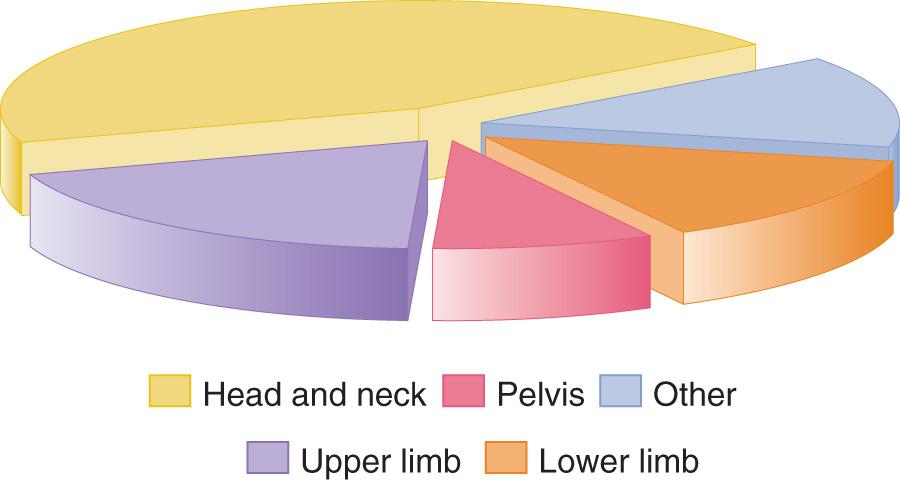
| Benign | Malignant |
| Reactive | Malignant peripheral nerve sheath tumors (MPNST) |
| Traumatic neuroma | (malignant schwannoma, neurofibrosarcoma) – Epithelioid MPNST – Pigmented (melanotic) MPNST – Peripheral primitive neuroectodermal tumor (Askin tumor) |
| Hamartoma: mucosal neuromas (MEN IIB, Gorlin's syndrome) | Autonomic nerve tumor (plexosarcoma) |
| Schwannoma (neurilemmoma) | Malignant melanoma of soft tissues (clear cell sarcoma) |
| Neurofibroma: solitary, multiple, diffuse, plexiform (NF-1) | |
| Perineurioma (storiform perineurial fibroma) | |
| Dermal nerve sheath myxoma | |
| Granular cell tumor |
Schwannomas originate from the neuroectodermal sheath surrounding peripheral nerves. They can arise in any part of the head and neck region, including the face, scalp, cranial cavity, orbit, middle ear, nasal cavity, oral cavity, larynx, and neck. Schwannomas also frequently arise from cranial nerves V, VII, VIII, and X and the sympathetic chain. On rare occasions schwannomas can be seen in the glossopharyngeal or hypoglossal nerves and even less commonly in other cranial nerves. Schwannomas are usually solitary neoplasms. Multifocal presentation raises the suspicion for neurofibromatosis type 2 (NF2), which results from inherited mutations in the NF2 suppressor gene. The formation of nonfamilial schwannomas also has been attributed to somatic alterations of the NF2 gene. Histologically, schwannomas show pallisading nuclei from Verocay bodies in the cellular Antoni A areas. They are strongly and diffusely immunoreactive to S-100 protein ( Figs. 14.4 and 14.5 ).
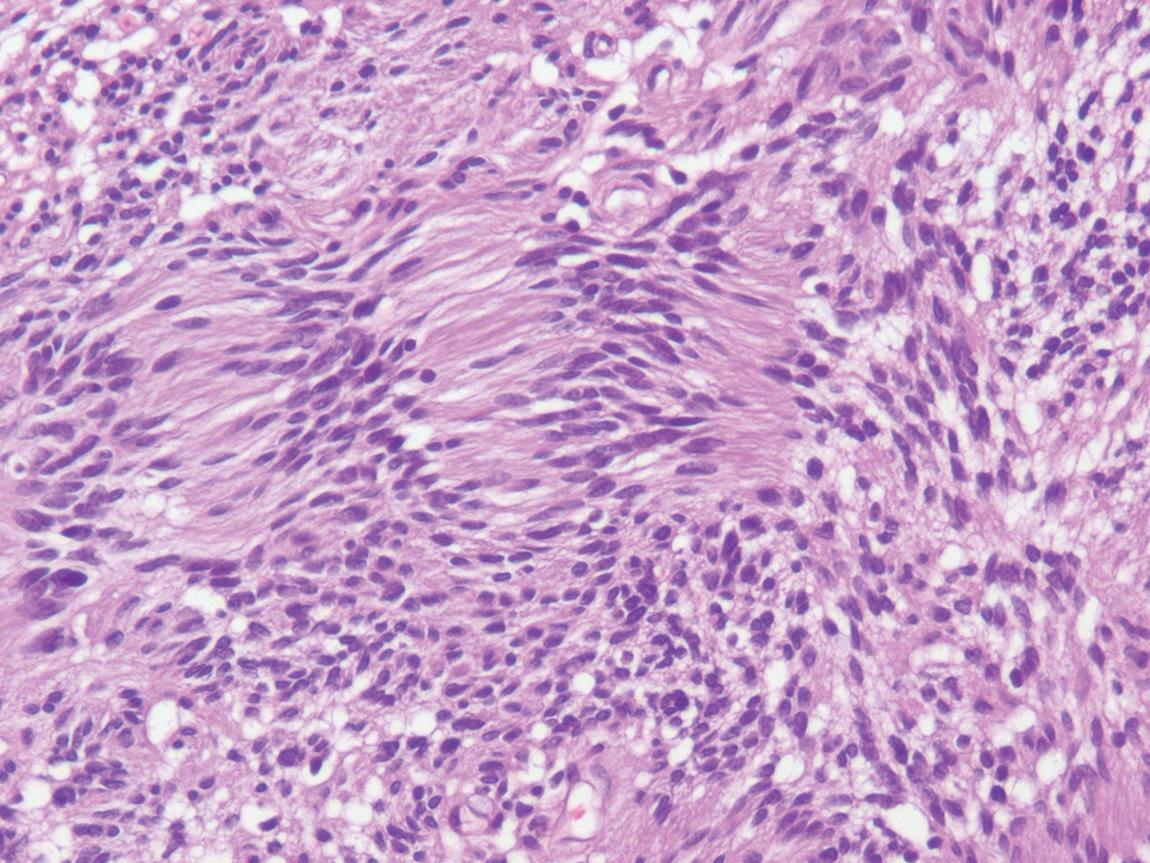
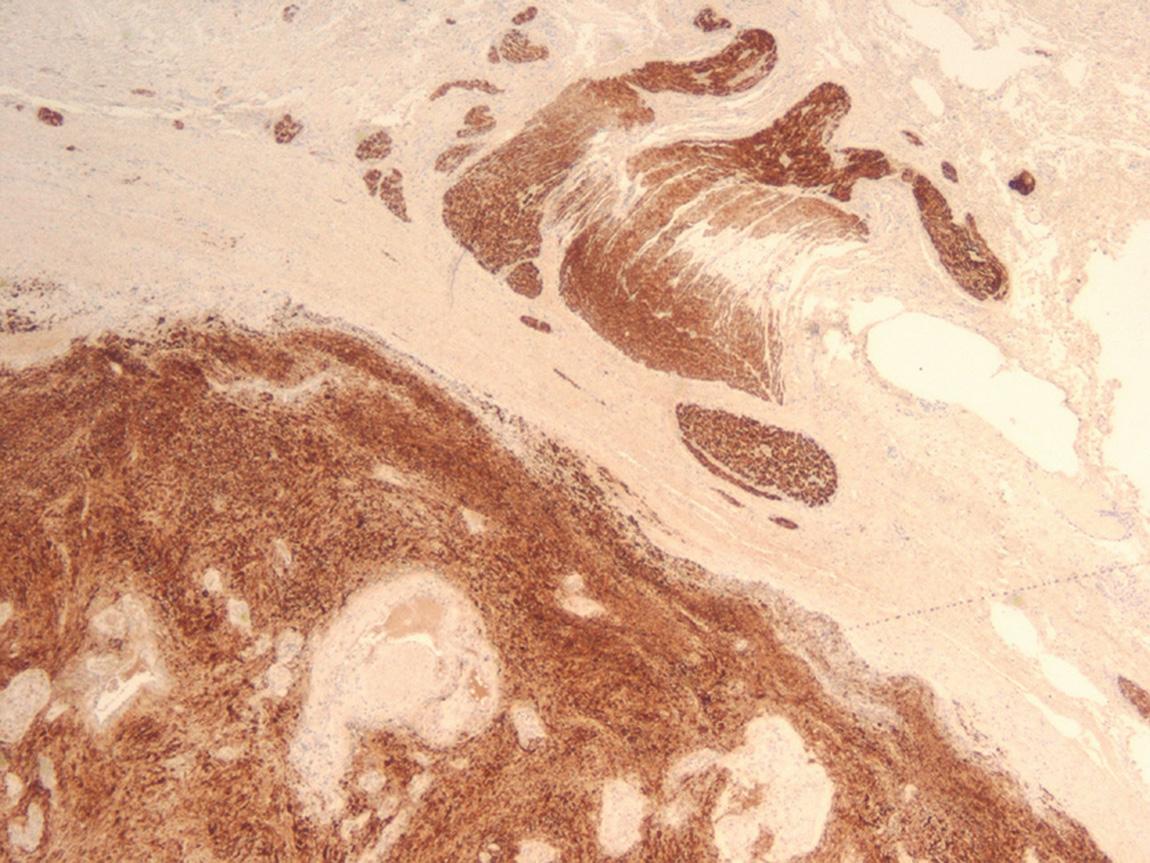
Neurofibromas are benign, unencapsulated tumors that may be localized, diffuse, or plexiform and are either familial or sporadic. The presence of a plexiform neurofibroma is virtually pathognomonic of familial neurofibromatosis (NF1). Neurofibromas typically present as ill-defined lesions in the scalp and skin of the head and neck. They occasionally may be seen from terminal branches of the trigeminal nerve in the sinonasal tract or in the larynx. Cutaneous neurofibromas have a raised, plaquelike appearance and are slow-growing, painless lesions that may be located in the dermis or in the subcutaneous fibroadipose tissue. Their borders can be indistinct, contributing to the high rates of incomplete excision and subsequent recurrence. Histologically, neurofibromas show loosely arranged collagen fibrils with small uniform nuclei. They are also positive for S-100 protein, although not as strongly as schwannomas ( Fig. 14.6 ).
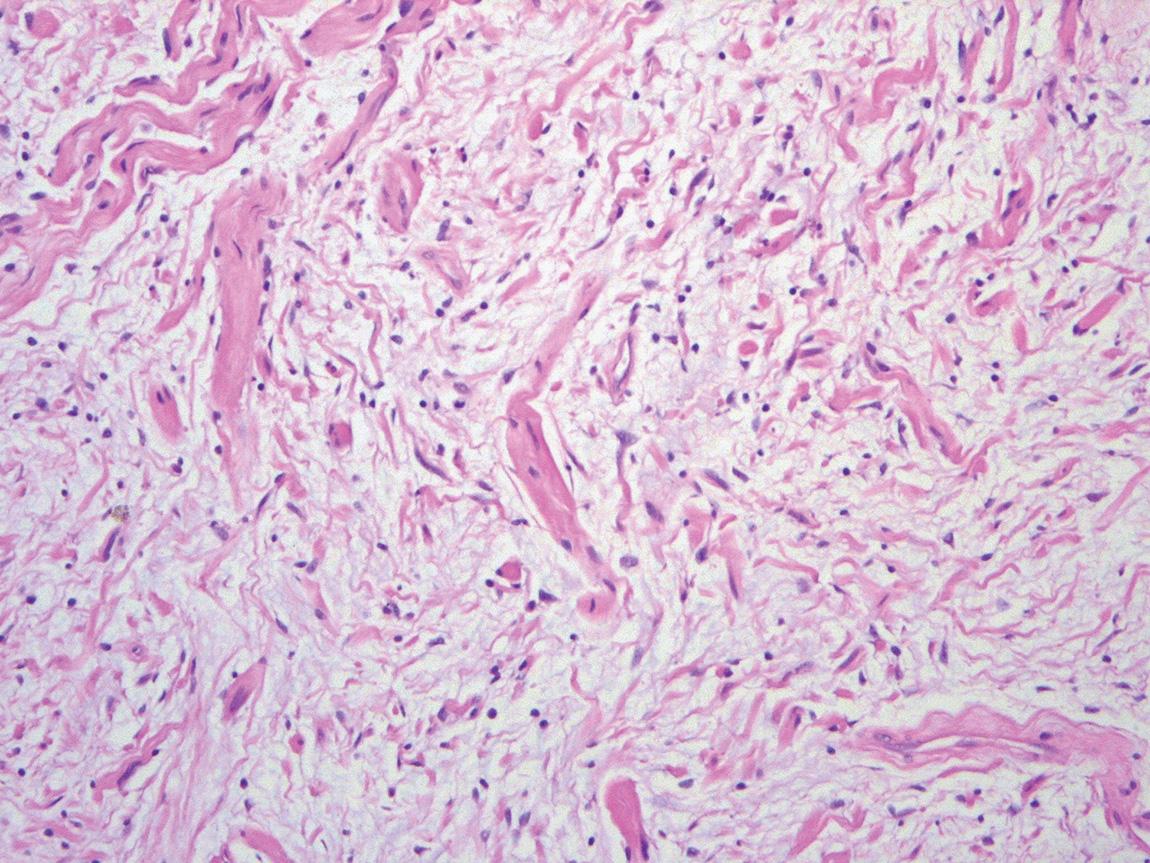
Malignant peripheral nerve sheath tumors (MPNSTs) are of Schwann or perineurial cell origin and arise either de novo or from a preexisting neurofibroma (NF1). At least two-thirds of MPNSTs are derived from neurofibromas in patients with NF1, and approximately 10% are induced by radiation. De novo MPNSTs most commonly occur in the fourth decade of life. When seen in conjunction with NF1, MPNSTs occur in younger patients and have a male predominance. In the sinonasal tract and nasopharynx, MPNSTs commonly arise from the ophthalmic and maxillary branches of the trigeminal nerve, but these tumors can arise from any cranial nerve. Quite rarely these tumors occur in the larynx, where they may cause mucosal ulceration. Operative findings of a thick pseudocapsule and firm adherence to surrounding soft tissue are harbingers of malignancy, and inspection of the cut surface of an MPNST often reveals hemorrhage and necrosis. Histologically, MPNSTs may be spindled or epithelioid. MPNSTs demonstrate immunoreactivity for the S-100 protein, but not to the same extent or intensity as a schwannoma. The local recurrence rate is quite high, and distant metastases can occur to the lungs, bone, and liver.
Paraganglia are neural cell aggregates of the sympathetic or parasympathetic nervous system and they typically reside in the adventitia of blood vessels and nerves. Whereas sympathetic paragangliomas secrete catecholamine and most commonly occur in the adrenal medulla, those of parasympathetic origin typically do not secrete catecholamines and primarily occur in the head and neck region. The distribution of paragangliomas of the head and neck region is shown in Fig. 14.7 . Most paragangliomas in the head and neck region arise in the carotid body jugulotympanic region, vagal body, superior and inferior laryngeal paraganglionic tissue, nasal cavity, or the orbit, reflecting the distribution of parasympathetic ganglia.
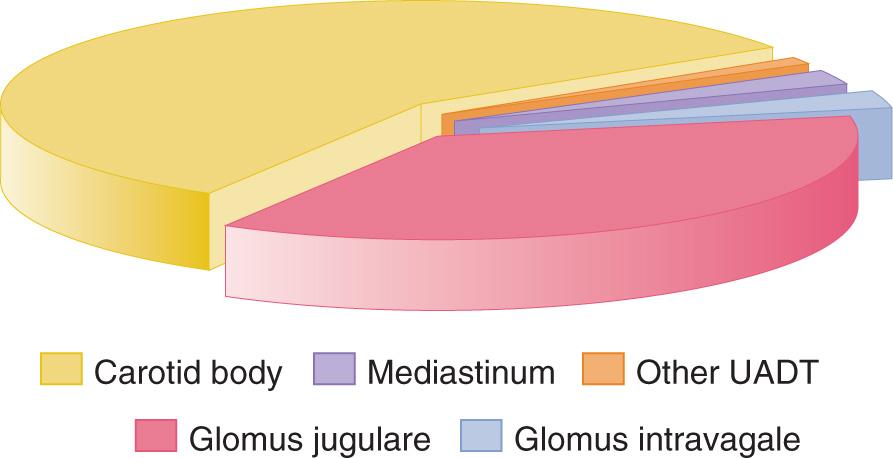
Paragangliomas typically occur in older persons, are unifocal, and are histologically benign. However, approximately 10% of head and neck paragangliomas can be malignant, 10% are bilateral or multiple, and 10% occur in patients with a family history of paragangliomas. Rarely, paragangliomas are functioning, and in those instances, patients present with a history of episodic flushing of the face and hypertension. In such patients, appropriate systemic imaging studies to rule out other paragangliomas should be undertaken, and serum and urinary catecholamine levels should be measured to establish an accurate diagnosis.
Carotid body tumors (also known as chemodectomas or nonchromaffin paragangliomas) are by far the most common of all paragangliomas in the neck and are more common in persons residing at high altitudes. Carotid body tumors arise from the chemoreceptor cells in the carotid sheath, which most commonly are located at the bifurcation of the carotid artery. These tumors are slow growing, are highly vascular, and are histologically benign in most instances. The characteristic location is in the upper part of the neck, where it may present as an external mass, or it may appear as a parapharyngeal mass pushing the lateral pharyngeal wall medially in the oropharynx. In either location, the mass usually has palpable pulsations. If the clinical diagnosis of a carotid body tumor is suspected, appropriate radiographic studies must be performed before deciding on a management plan. Shamblin classified carotid body tumors into three categories, based on the relationship of the carotid arteries and the adjoining nerves to the tumor ( Fig. 14.8 ). In type I, the external and internal carotid arteries are simply displaced by the tumor, and the hypoglossal and superior laryngeal nerves lie on the surface of the tumor. In type II, the tumor is indented by the external and internal carotid arteries, making a deep groove within the tumor, and the hypoglossal and superior laryngeal nerves are on the tumor's surface. In type III, the arteries are encased by the tumor.
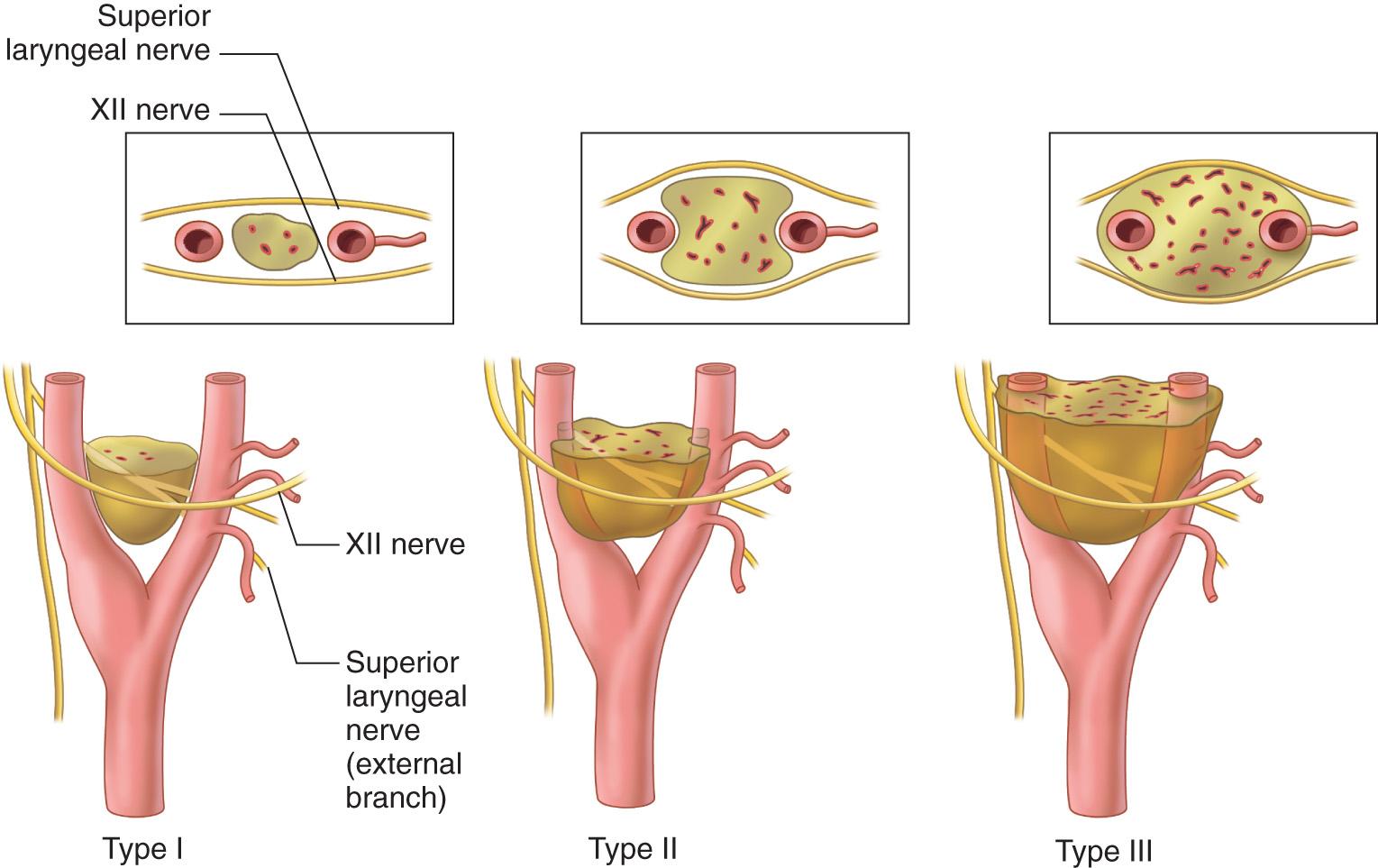
Although they are rare, malignant paragangliomas have a significant potential for local invasion, cranial nerve paralysis, and regional or distant metastases. Histologically, paragangliomas have a characteristic nested or “Zellballen” appearance. Immunohistochemical staining shows positivity for S-100 protein, and a chromogranin stain for the cytoplasm of chief cells shows neurosecretory granules ( Figs. 14.9 through 14.11 ). Benign paragangliomas and malignant paragangliomas have a similar histologic picture, and often it is difficult for pathologists to differentiate between the two. Therefore the diagnosis of a malignant paraganglioma is made on the basis of the following features: (1) local invasion, cranial nerve paralysis, invasion of the carotid artery, or infiltration of the soft tissues in the parapharyngeal space or bone destruction at the skull base; (2) the presence of regional lymph node metastasis; or (3) distant metastasis. Clinically, adherence of the tumor with reduced mobility or cranial nerve paralysis suggests malignancy. Upon radiologic imaging, the presence of regional lymph node metastasis and evidence of invasion and infiltration into adjacent structures would raise suspicion of the tumor being malignant.

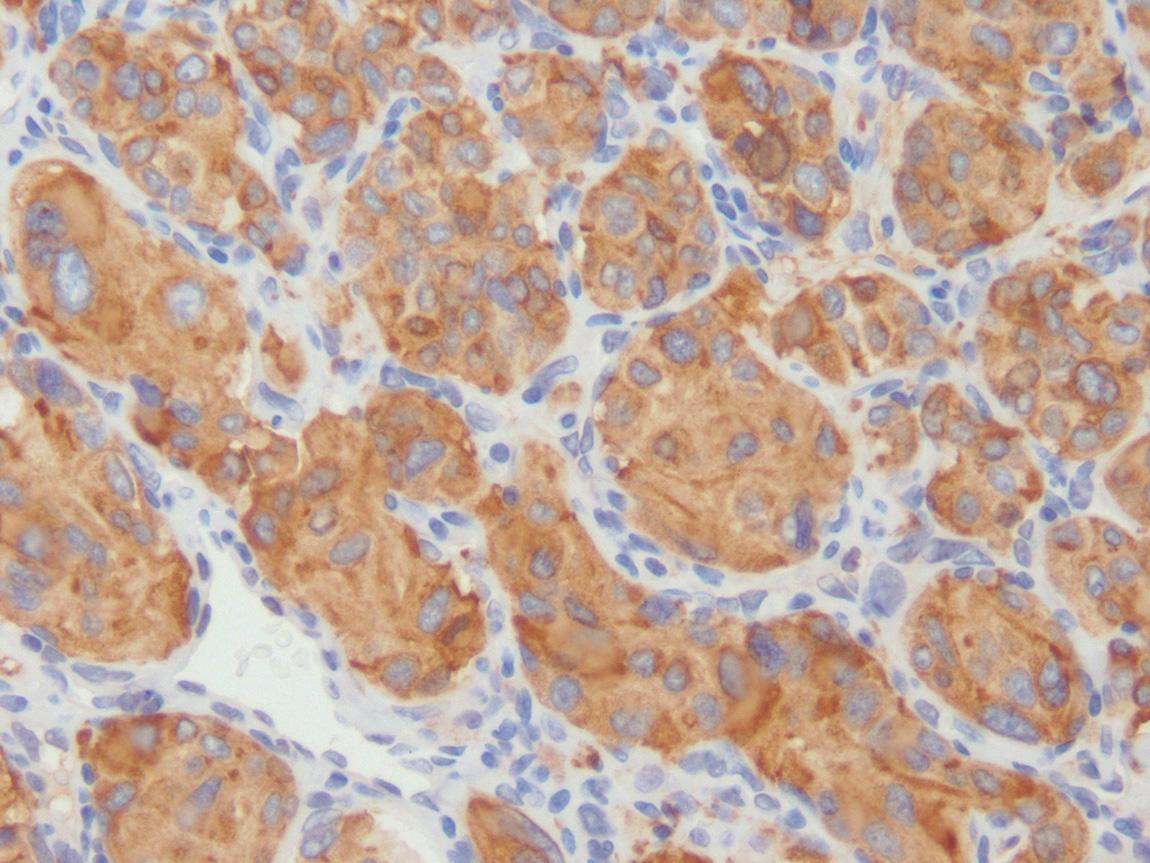
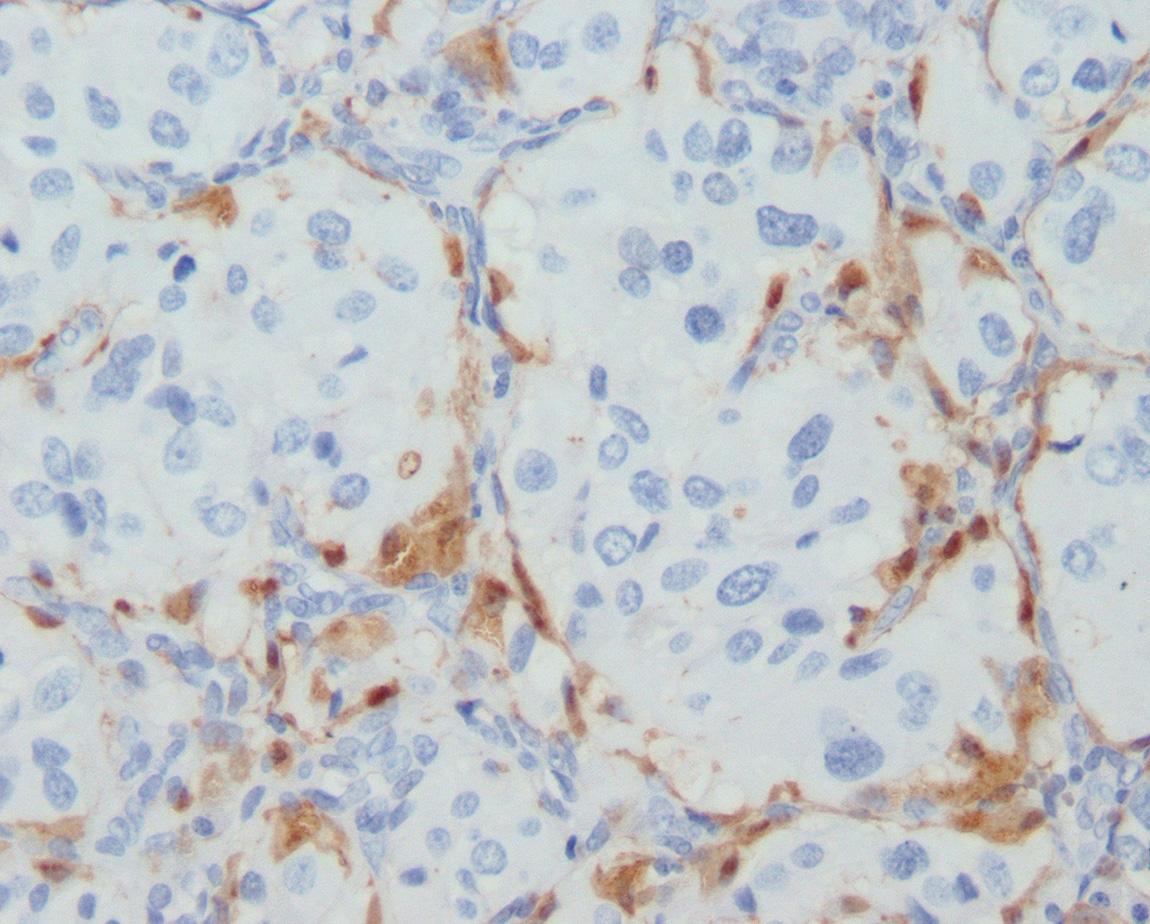
Paragangliomas that appear in younger patients and/or present in multiple locations raise concern for a genetic predisposition. Linkage analysis has identified four possible loci, termed “paraganglioma loci 1 to 4” (PGL 1, PGL 2, PGL 3, and PGL 4). Although the gene in PGL 2 remains to be identified, PGL 1, PGL 3, and PGL 4 have been identified as succinate dehydrogenases (SDHs), including SDHD, SDHC, and SDHB, respectively. These genes encode for components of the four-subunit mitochondrial complex II (also known as the succinate ubiquinone oxidoreductase ) that is involved in electron transport and the Krebs tricarboxylic acid cycle. The mitochondrial complex II is one of five complexes in the mitochondrial electron transport chain; it catalyzes conversion of succinate to fulminate and is essential for normal development. Homozygous defects in the mitochondrial complex II result in Leigh syndrome (associated with severe neurologic impairment), whereas heterozygous defects result in paraganglioma and pheochromocytoma development. The wild-type allele often is inactivated in paragangliomas ( Table 14.2 ).
| SDHB (PGL4) | SDHC (PGL3) | SDHD (PGL1) | |
|---|---|---|---|
| Chromosomal locus | 1p35-36 | 1q21 | 11q23 |
| Inheritance | Monogenic, autosomal dominant | Monogenic, autosomal dominant | Monogenic, autosomal dominant with paternal imprinting |
| Penetrance | >75% | >75% | ? |
| Pheochromocytoma | + | − | + |
| Percent with head and neck tumors | 15%-50% | 50%-100% | 50%-100% |
| Frequency | 5%-10% of cases | <5% | 80%-90% of cases |
| Malignancy | + (5%-35%) | − | − |
| Multicentricity | 15%-50% | ~10% | 50%-90% |
PGL 2, SDHB, and SDHC are inherited as autosomal dominant traits. The SDHD gene is imprinted from the paternal line, and thus the phenotype is only inherited from the father. Penetrance is variable but is relatively high overall. Patients usually present by the first decade of life; fewer than 5% of paragangliomas are familial in patients older than 50 years. Although paragangliomas are common to all subtypes, pheochromocytomas also can develop in patients with PGL 1 and PGL 4.
Genetic testing is advocated for patients presenting with multiple paragangliomas or a suggestive family history. In addition, testing should be considered in patients with extraadrenal sympathetic paragangliomas or in younger patients, because germline mutations can be detected in SDHB or SDHD in up to 20% of the cases. The management of familial paraganglioma is a matter of debate. Retrospective studies suggest that intervention may do little to affect the long-term outcome, and observation may be warranted in most cases. Surgery should be considered in patients with carotid body tumors and tumors with rapid growth or significant symptoms.
The majority of patients with neurogenic tumors and paragangliomas in the head and neck region are asymptomatic. Presentation with a mass that is accidentally discovered in the neck or is consequent to an incidental finding on an imaging study, such as a computed tomography (CT) or magnetic resonance imaging (MRI) scan performed for other reasons, is common. Tumors arising from the lower cranial nerves usually present in the retromandibular region of the upper part of the neck with ill-defined fullness, and they can be pulsatile. The pulsatile nature of the mass reflects increased vascularity or, more commonly, transmitted pulsations from the carotid vessels. On the other hand, schwannomas and neurofibromas arising in the lateral aspect of the neck present as firm, discrete lesions without pulsations. These tumors usually are mobile in an axis perpendicular to the long axis of the nerve.
In the great majority of cases, the nerve of origin of schwannomas or neurofibromas retains its function. Presentation with paralysis of the involved cranial nerve is rare and should raise concern for malignancy. Neurogenic tumors and paragangliomas in the PPS often present as a submucosal mass in the lateral pharyngeal wall, pushing the tonsil and soft palate medially. Neurofibromas arising from sensory nerves occasionally are painful to touch and pressure.
Diagnosis of these tumors is usually made through clinical assessment and radiologic imaging. Biopsy and tissue diagnosis is seldom required and indeed may be hazardous. Fine-needle aspiration biopsy may establish the diagnosis of neurogenic tumor but is not helpful for paragangliomas. An open biopsy of a paraganglioma causes significant hemorrhage and should be avoided. A transoral open biopsy of a parapharyngeal mass should not be performed.
Modern radiologic imaging has revolutionized the diagnosis and management of neurovascular lesions in the head and neck region. In the past, direct angiography was the only confirmatory radiographic test for a carotid body tumor or paraganglioma. However, with the advent of CT and MRI scanning, direct angiography is seldom performed today unless preoperative embolization of the tumor is required. CT angiography and MRA also provide a noninvasive means of angiography and three-dimensional reconstruction. As such, these imaging studies play an essential role in aiding preoperative diagnosis, surgical planning, or monitoring growth if a decision is made to observe these tumors.
Most neurogenic and vascular tumors of the suprahyoid neck arise from within the carotid space (CS). The CS spans the entire neck from the skull base to the aortic arch. Its contents include the carotid artery, internal jugular vein, cranial nerves IX to XII, and the sympathetic chain. The X nerve lies posterior and lateral to the carotid artery, whereas the sympathetic chain lies posterior and medial to the artery. Although it is a continuous space, the CS is further subdivided into the suprahyoid and infrahyoid portions, with the suprahyoid portion anatomically related to the PPS and the most common site of origin of neurovascular tumors in the head and neck. The suprahyoid CS is located posterior to the PPS and extends superiorly into the carotid canal and jugular foramen at the skull base ( Fig. 14.12 ).
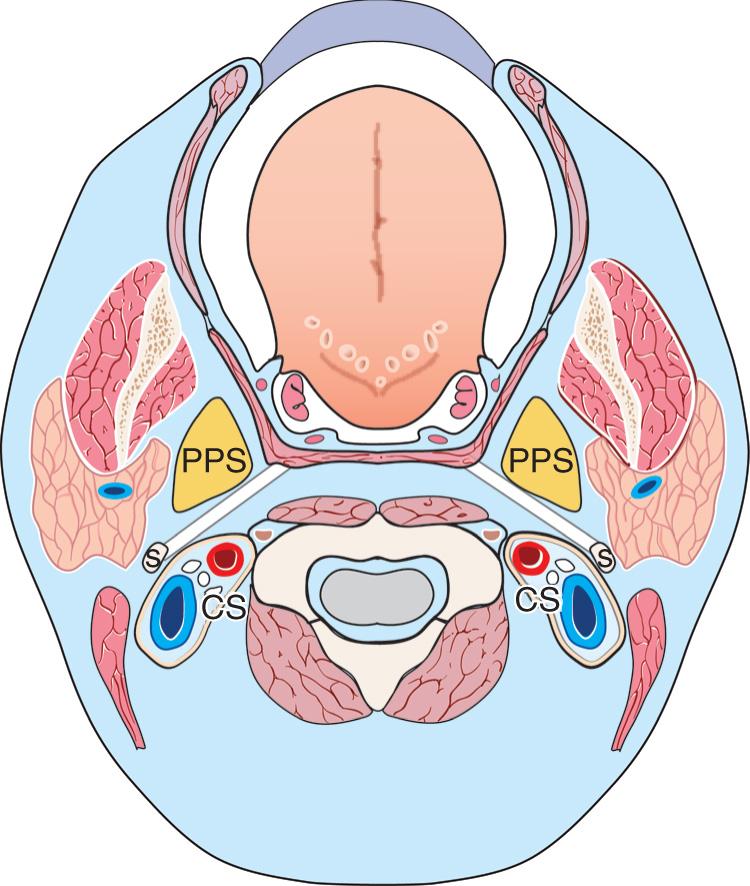
When assessing the imaging, it is important to examine contiguous slices on CT or MRI to avoid confusing anatomic variations such as a dominant jugular vein or tortuous carotid artery. In general, the distinction between suprahyoid CS and PPS tumors can be made simply by assessing the direction of displacement of the fat in the PPS ( Fig. 14.13 ). Tumors originating in the CS characteristically displace the PPS fat and internal carotid artery anteriorly and the internal jugular vein laterally. In contrast, tumors of the PPS result in posterior displacement of these structures.

The two most common tumors in the suprahyoid CS, paragangliomas and nerve sheath tumors, can be distinguished radiographically, because paragangliomas are very vascular tumors. Paragangliomas enhance intensely on CT and MRI and have flow voids on MRI ( Fig. 14.14 ). Although flow voids are diagnostic of paragangliomas, they may not be readily apparent if the tumor is less than 2 cm in diameter. A contrast-enhanced CT scan can help make the diagnosis in these situations, because paragangliomas become intensely enhanced compared with nerve sheath tumors that may or may not become enhanced. Paragangliomas on the CT scan show enhancement and have a characteristic spindle-shaped appearance on the coronal or sagittal views ( Fig. 14.15 ). MRI, on the other hand, characteristically shows the flow voids and also demonstrates the spindle-shaped nature of the tumor giving a “rat tail” appearance on coronal and sagittal sections ( Fig. 14.16 ).
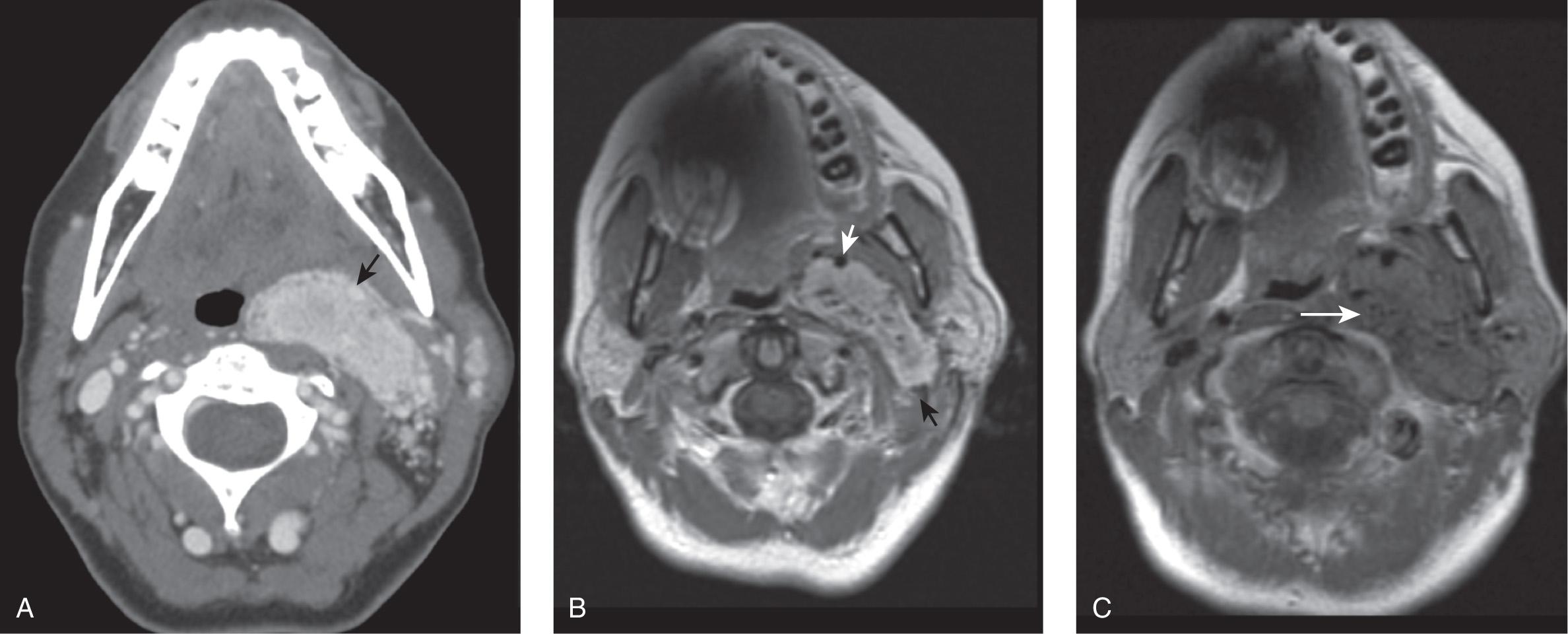
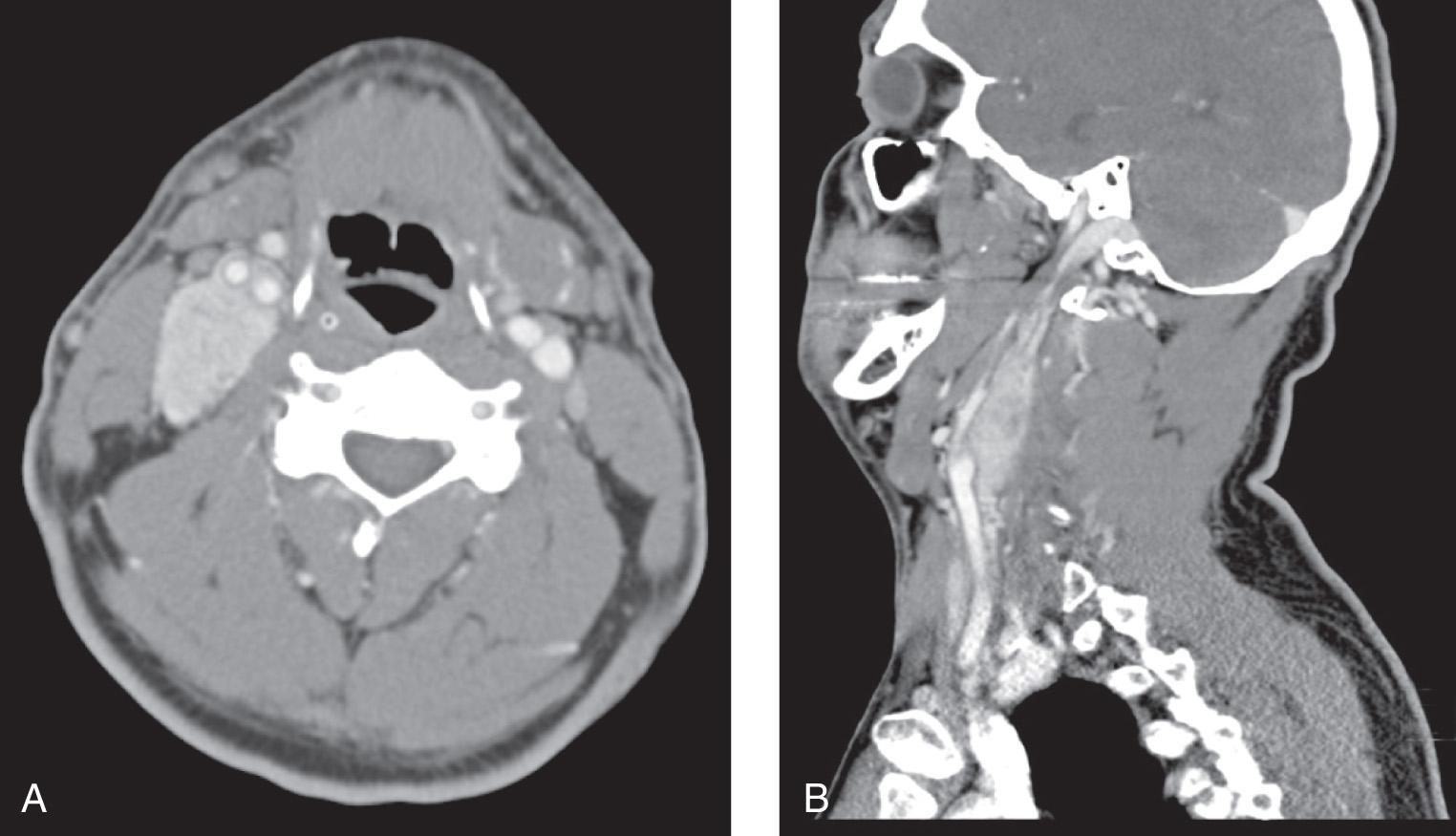
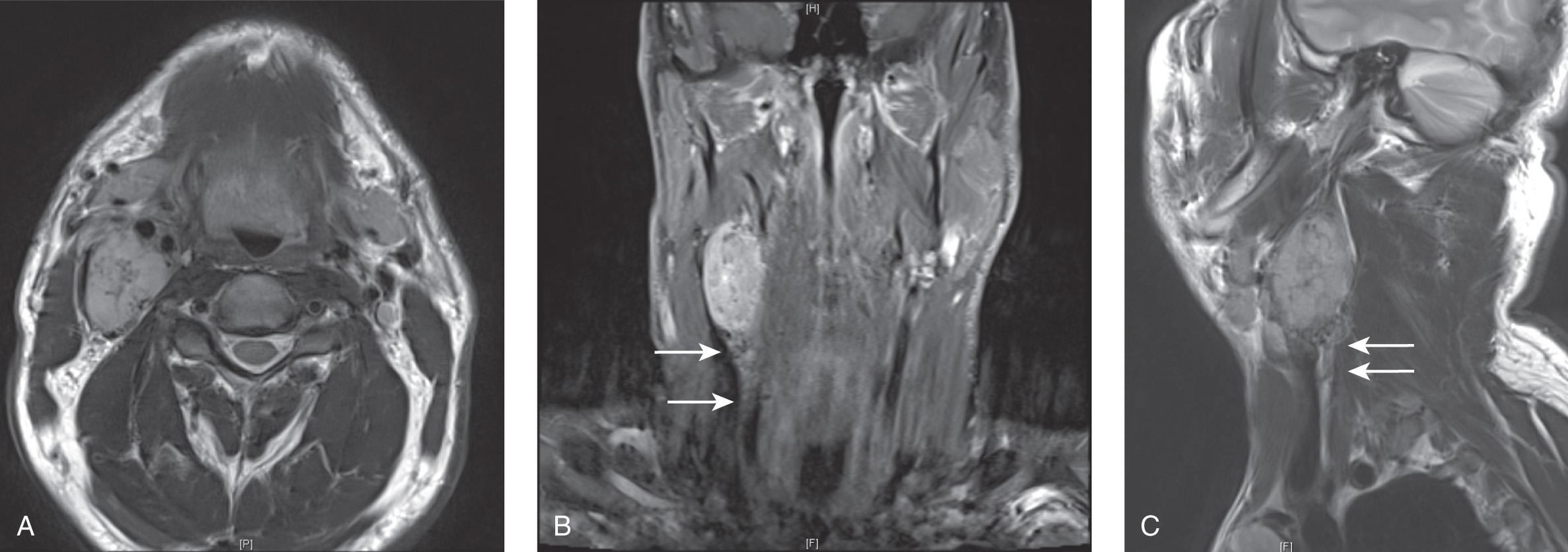
The classic carotid body tumor is located within the carotid bifurcation in the infrahyoid neck and therefore is not in immediate proximity to the PPS. It tends to splay the internal carotid artery and the external carotid artery at the carotid bifurcation ( Fig. 14.17 ). Carotid body tumors enhance intensely on a contrast-enhanced CT scan ( Fig. 14.18 ). The location of the external and internal carotid artery in relation to the tumor is crucial in surgical treatment planning. The carotid vessels may be superficial to the tumor, indenting into the tumor, or encased by the tumor. To assess these relationships, it is often necessary to obtain a contrast-enhanced CT scan with three-dimensional reconstructions, as well as a contrast-enhanced MRI for detailed assessment of the location and extent of the tumor and its relation to the carotid arteries ( Fig. 14.19 ). Three-dimensional reconstructions are also helpful in differentiating various types of carotid body tumors in relation to the carotid arteries ( Fig. 14.20 ). Complete evaluation of the imaging studies is necessary, since some patients may present with multiple paragangliomas on the same side of the neck or bilaterally ( Fig. 14.21 ). In contrast to a carotid body tumor, a glomus vagale tends to displace the carotid artery anteriorly ( Fig. 14.22 ). Unlike carotid body tumors, other paragangliomas often have demonstrable feeder vessels that most commonly arise from the ascending pharyngeal artery. It is important to point out that these feeder vessels are not readily apparent on noninvasive vascular imaging such as computed tomographic angiography (CTA) or magnetic resonance angiography (MRA) ( Fig. 14.23 ). Conventional angiography would be needed to demonstrate the feeder vessels and is recommended only if embolization is part of the treatment plan ( Fig. 14.24 ).
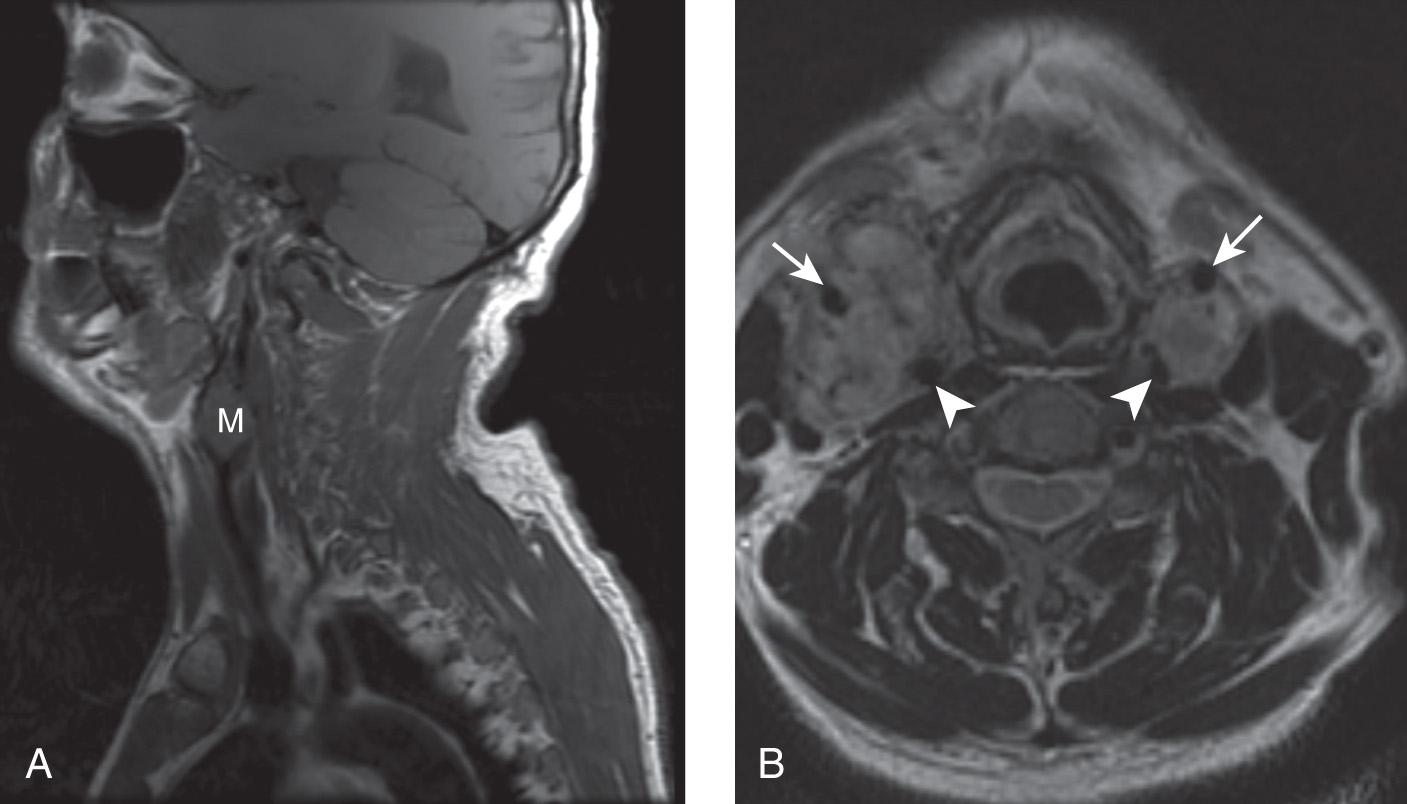
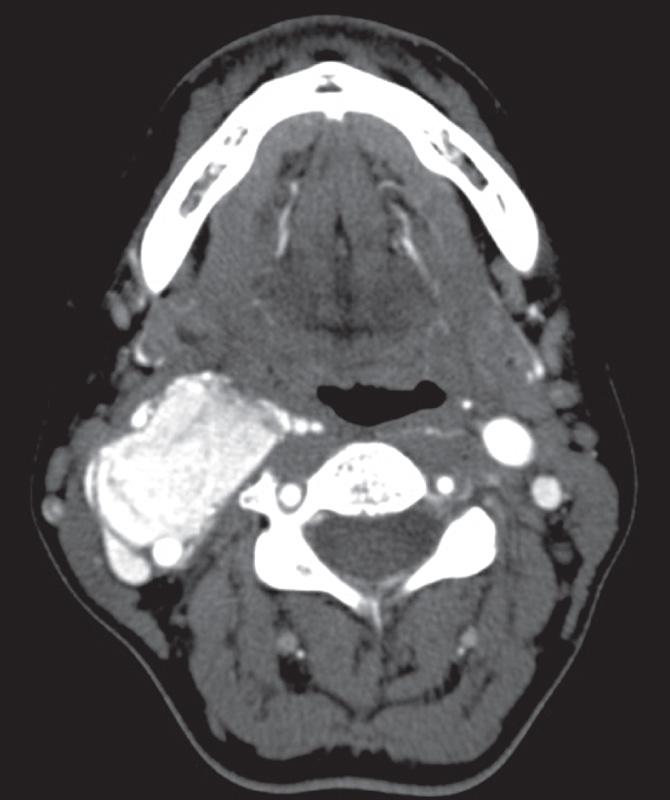
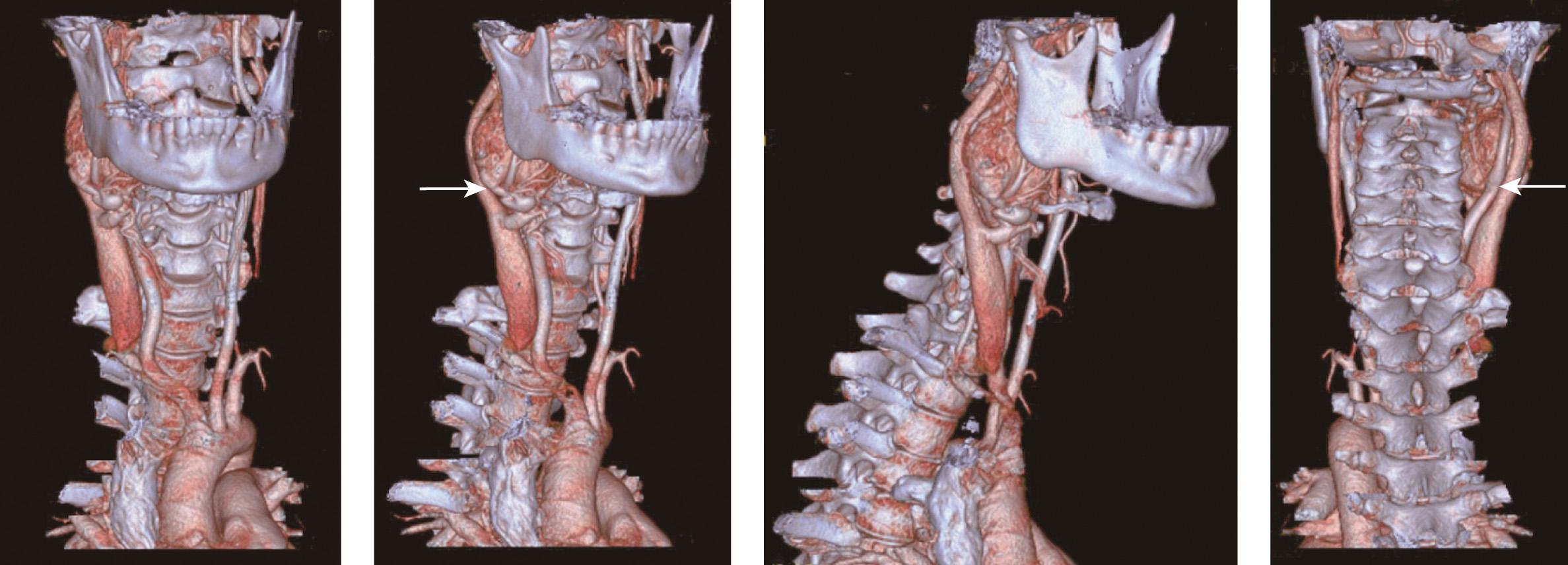
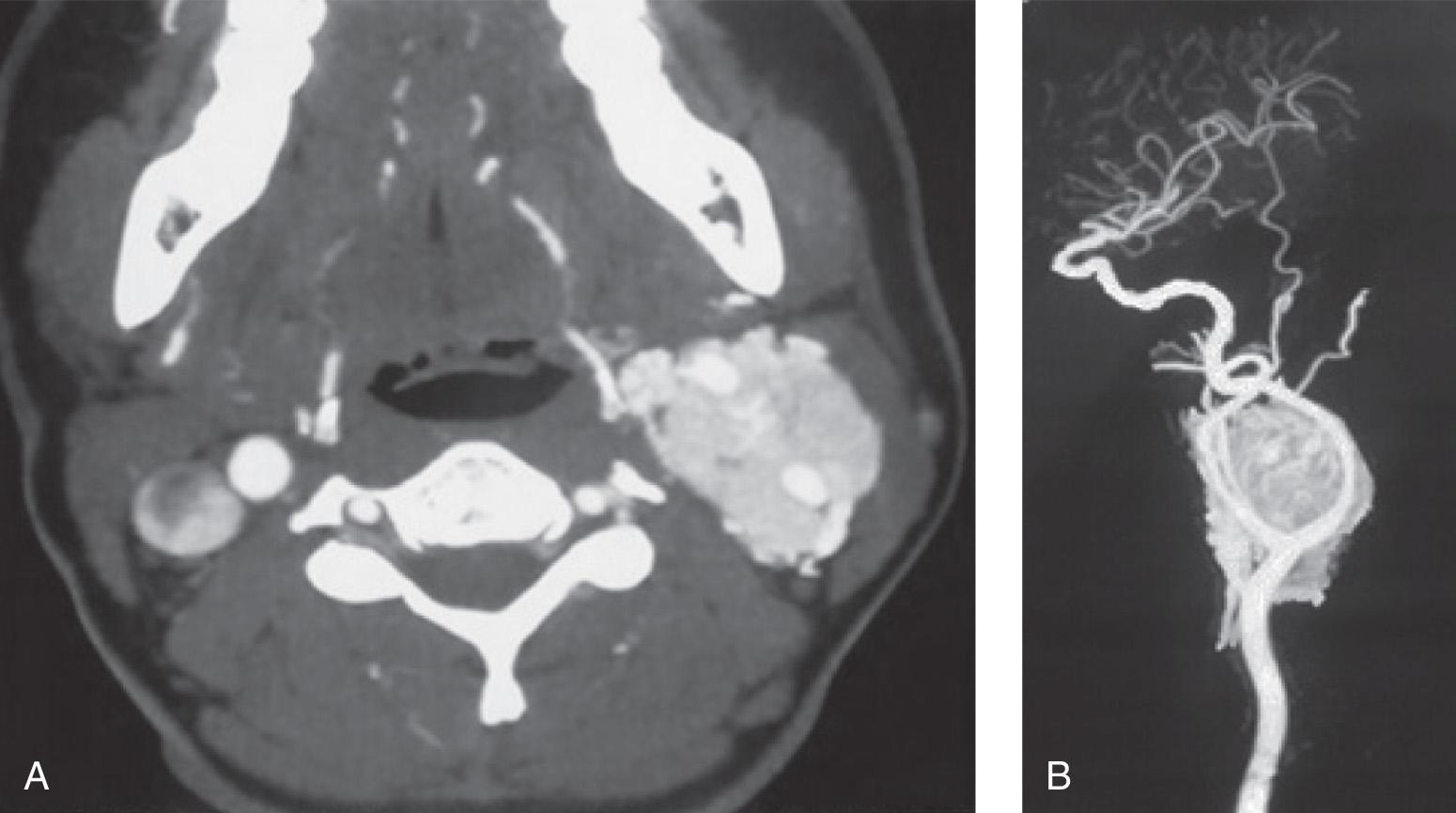
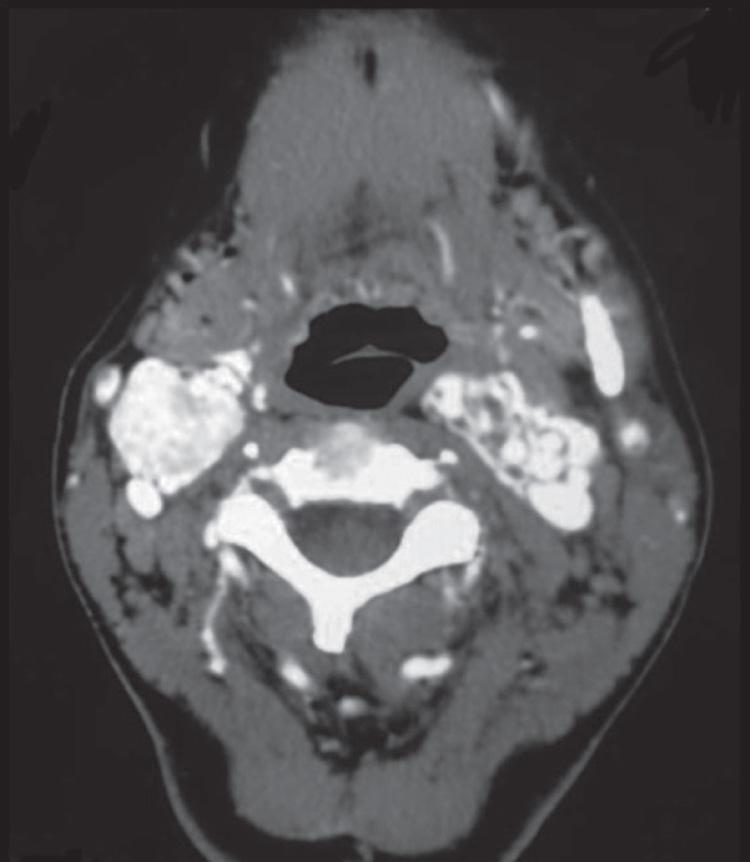
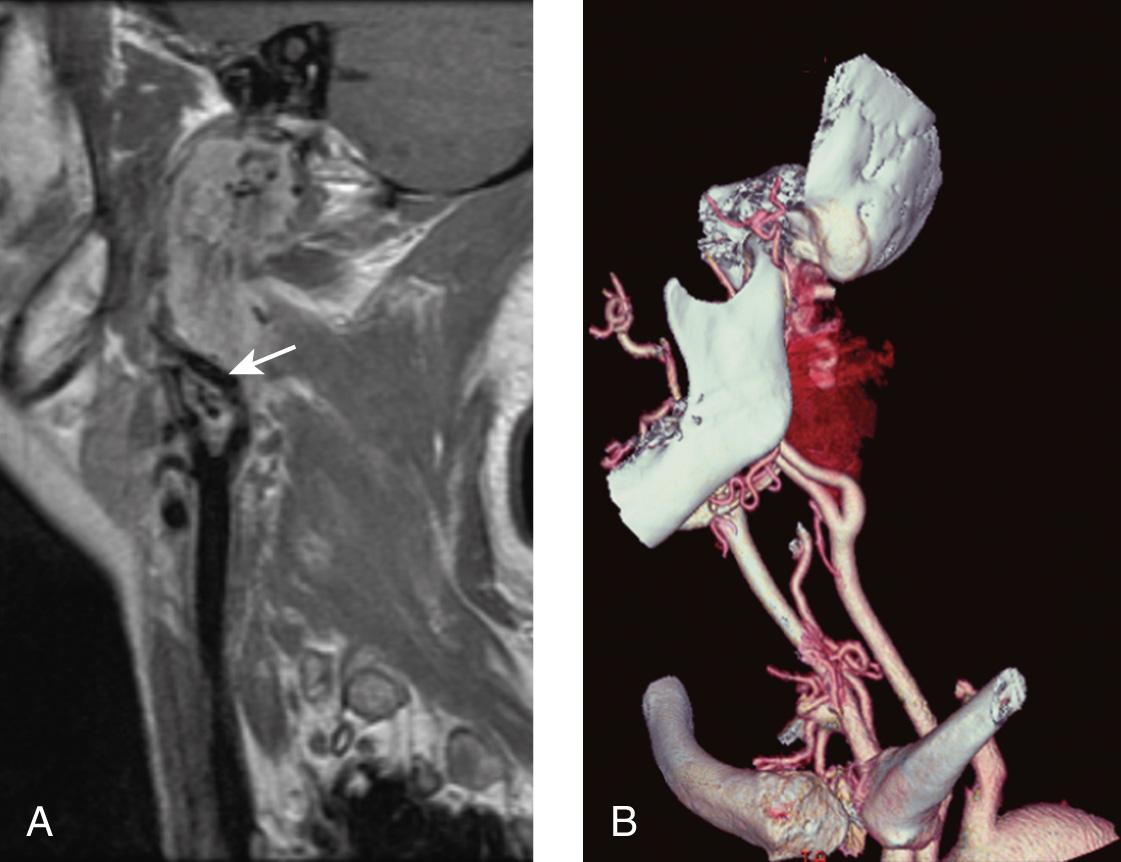

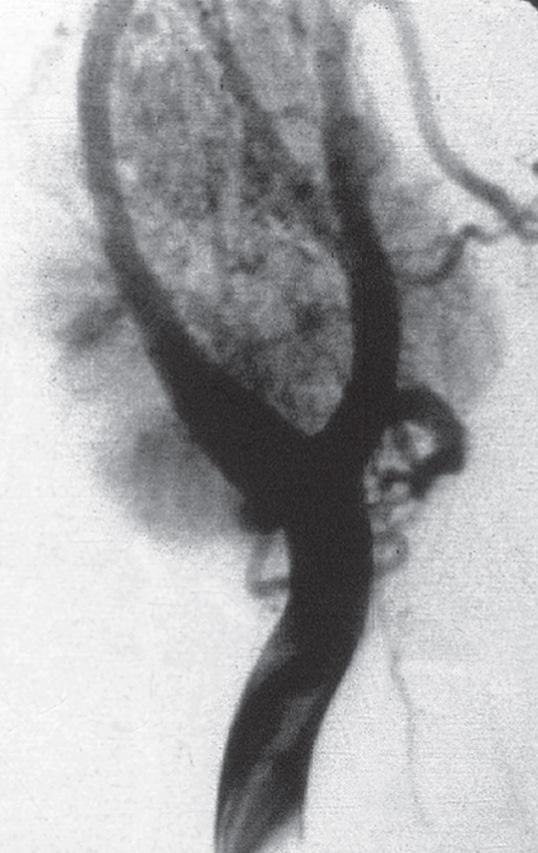
Radiographic differentiation of a schwannoma from a neurofibroma is not straightforward. Heterogeneity within the lesion is more commonly seen in schwannomas because of a cystic change or hemorrhage. Schwannomas are well-encapsulated tumors that appear as round or ovoid masses. On MRI they are isointense to muscle on T1 and hyperintense on T2, and they become enhanced after administration of contrast ( Fig. 14.25 ). These imaging characteristics are by no means unique to schwannomas; paragangliomas can have similar imaging characteristics. However, as previously described, schwannomas do not have flow voids, even when they are large ( Fig. 14.26 and Fig. 14.27 ). The endoscopic view of a schwannoma of the retropharyngeal space projecting through the right posterolateral pharyngeal wall is shown in Fig. 14.28 . Typically, schwannomas do not show contrast enhancement on CT scan but are characteristically bright on T2-weighted MRI scan ( Fig. 14.29 ). In addition, schwannomas at the skull base generally cause regressive remodeling of bone, whereas permeative changes are seen more classically with paragangliomas.
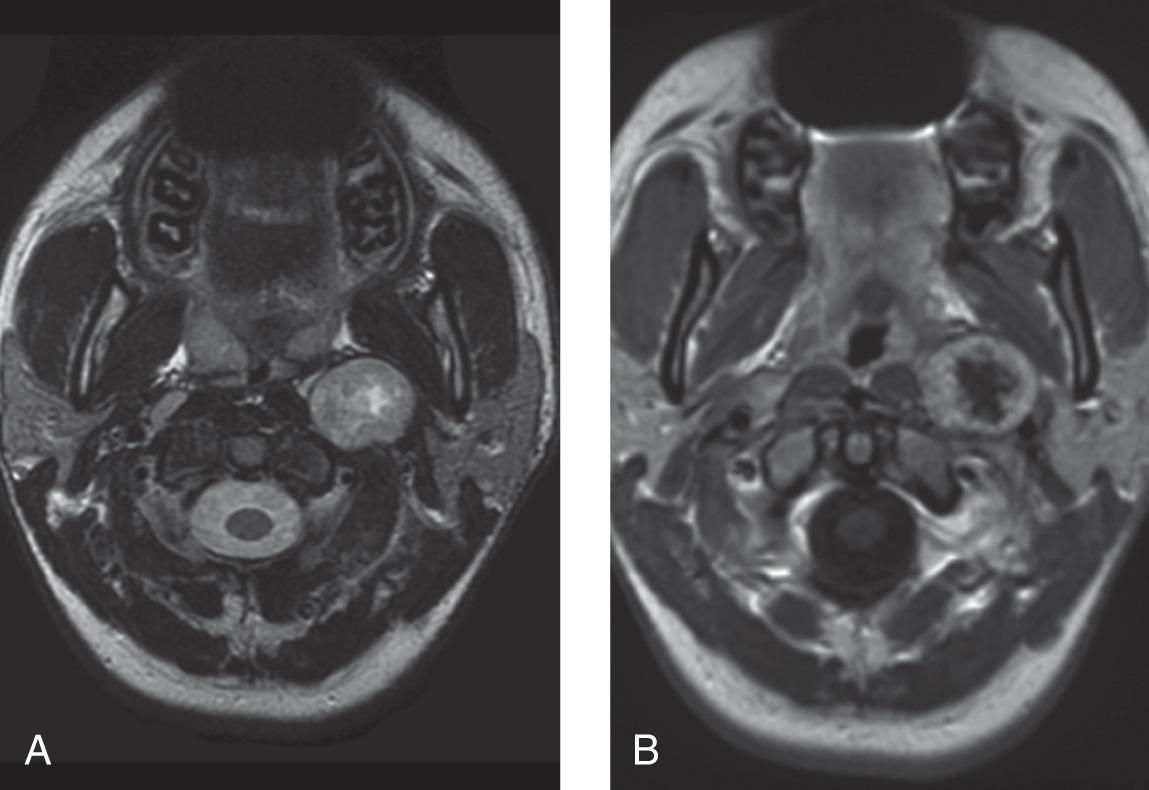
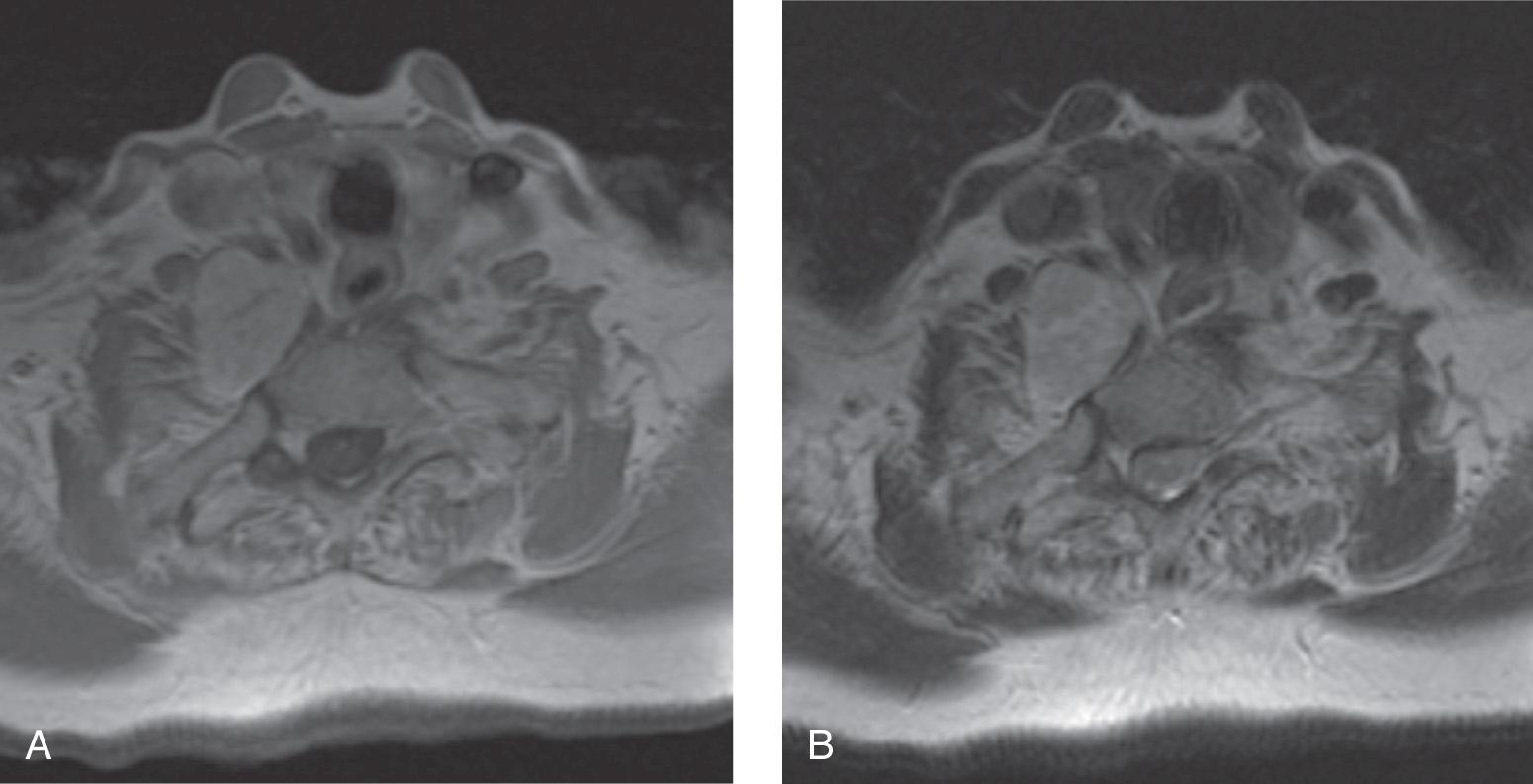

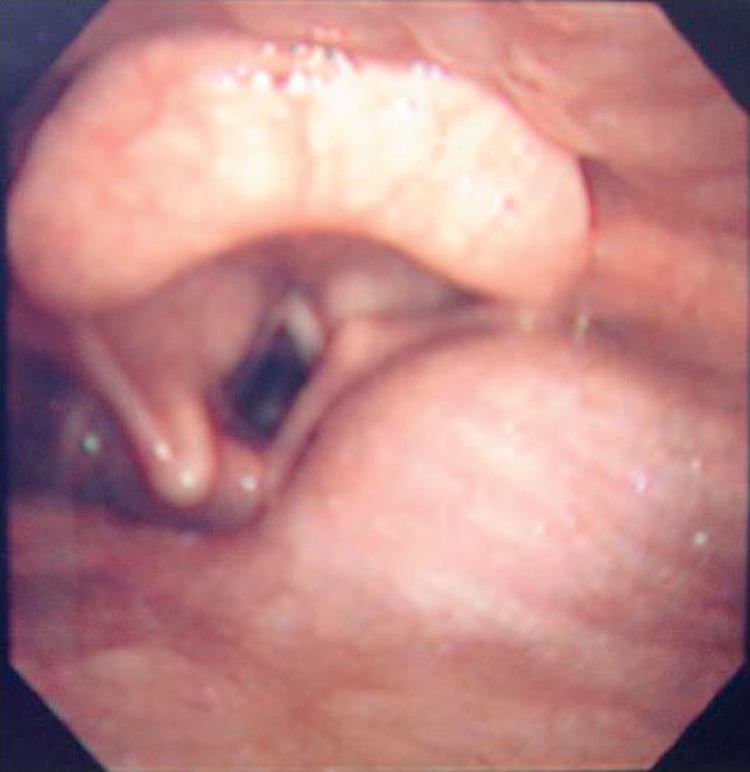

MRI also is of significant help in demonstrating neurogenic tumors with intraspinal and extraspinal extension (i.e., dumbbell tumors). A myelogram generally is not used unless MRI is contraindicated, because an MRI scan provides superior information with appropriate contrast enhancement ( Fig. 14.30 ). Noninvasive imaging generally does not provide functional information on the adequacy of cerebral circulation, and dedicated tests should be performed if carotid artery resection is a surgical possibility. These tests include balloon occlusion testing and/or radioactive xenon perfusion imaging.
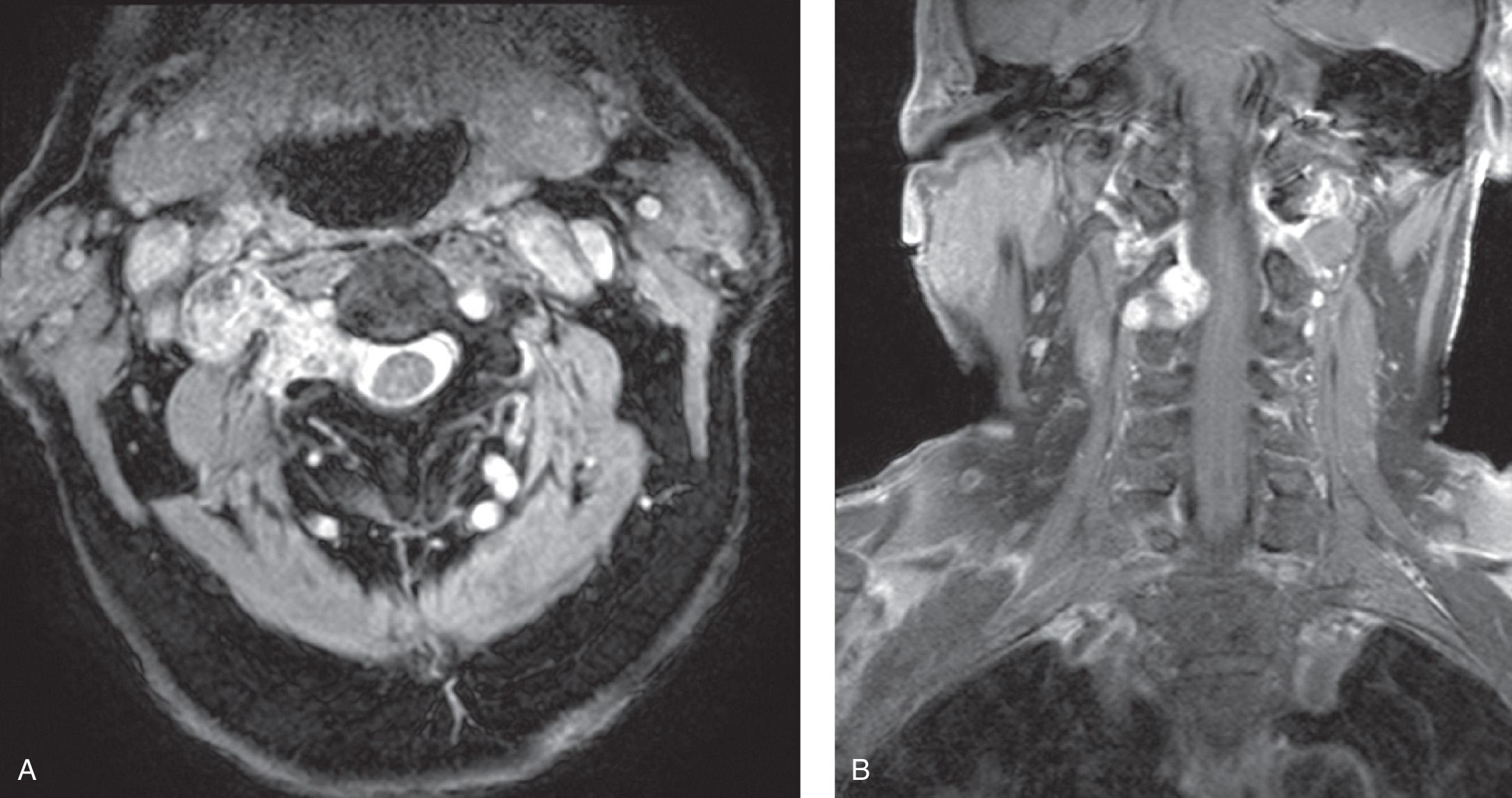
The management of neurogenic or neurovascular tumors in the head and neck has evolved considerably during the past three decades, along with a better understanding of the natural history of these tumors. Because surgery for carotid body tumors generally does not cause cranial nerve injury or deficit, most patients with carotid body tumors up to 6 to 7 cm without extension to the skull base are treated surgically. On the other hand, surgery for paragangliomas arising from the lower cranial nerves inflicts considerable morbidity. In the past, disability resulting from compromise of function of multiple cranial nerves as a result of a potential increase in the size of the tumor was considered an indication for early surgical intervention. Longitudinal population-based studies in the Netherlands have shown that these tumors grow very slowly (approximately 1 mm per year on average) and that surgical intervention often is associated with more detrimental effects than would be encountered with natural progression of the disease. These findings support the philosophy of observation as the definitive management in most patients. Accordingly, surgery is now used selectively, and the role of radiation in the management of these tumors under select circumstances is increasing.
Treatment selection is based on the size and location of the tumor, surgical risk, age and profession of the patient, and the potential risk of cranial nerve deficits resulting from surgery versus the potential benefit of nonsurgical treatment approaches. In general, younger patients with isolated tumors in whom the risk is limited to one cranial nerve are the best surgical candidates. Older patients who have larger tumors and a high risk for the injury of multiple cranial nerves should be treated nonsurgically. An algorithm for treatment selection for paragangliomas and schwannomas of the lower cranial nerves is shown in Fig. 14.31 .
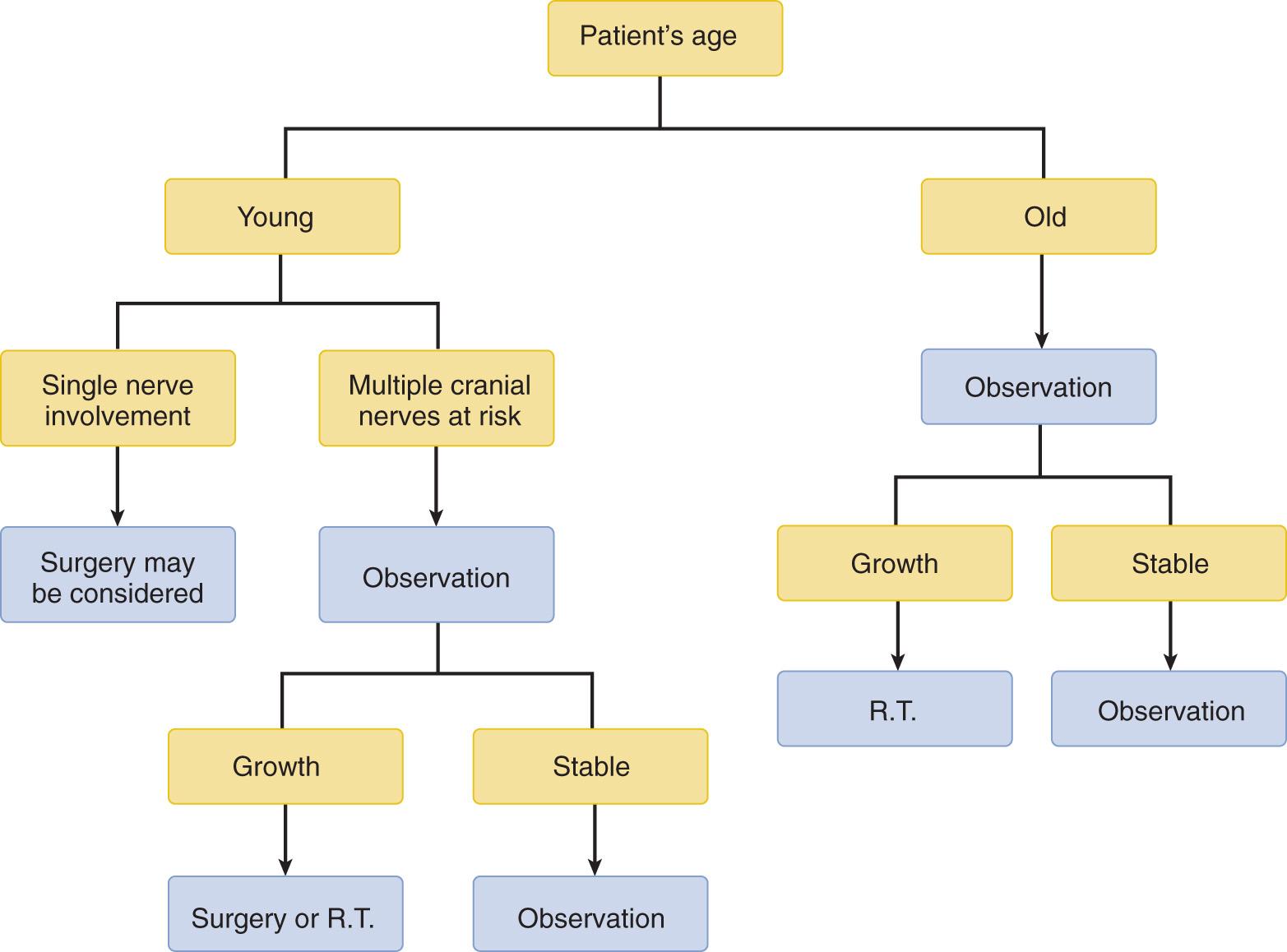
Once the diagnosis is established, observation of paragangliomas or schwannomas of the lower cranial nerves should be considered for most patients. A thorough and informed discussion with the patient and the family should take place. The pros and cons of surgery, observation, and radiotherapy should be discussed in detail. The possibility of future intervention should be discussed. Most importantly, the need for continued clinical and imaging surveillance should be emphasized. Close observation with serial radiographic imaging either with a CT or MRI is recommended. An annual MRI with contrast enhancement is adequate for surveillance for the first few years. If the tumor is relatively stable, the imaging may be extended to every 2 years. Development of symptoms or rapid tumor growth warrants consideration for intervention.
Accumulating evidence suggests that radiation therapy is effective in the treatment of schwannomas and paragangliomas. Radiation therapy does not eradicate the tumor, but it can arrest further growth, and thus on subsequent posttreatment imaging studies the tumor remains stable. Radiation delivery techniques, including conventional fractionated external beam radiotherapy, stereotactic radiosurgery, and gamma knife radiosurgery, have been shown to be safe. More recently, use of intensity-modulated radiation therapy has been increasing. The 10-year local progression-free rates range from 92% to 100% with radiation doses of 45 to 54 Gy. Although transient cranial nerve palsies have been observed, particularly with stereotactic radiosurgery, no permanent neuropathy has been reported. In selecting patients for treatment, the risk for a radiation-induced second malignancy needs to be balanced against the immediate and permanent risk of cranial neuropathies caused by surgical intervention. Based on this assessment, radiation therapy is generally not recommended for younger patients.
Patients with functioning paragangliomas present with a history of flushing and episodic hypertension. Appropriate medical management requires control of hypertension with alpha blockade. For young patients with large paragangliomas located high in the parapharyngeal space, surgical intervention poses the risk of multiple cranial nerve injuries. If the tumor in a young patient shows progressive growth, then intervention is required for tumor control. Because radiotherapy in young patients poses the danger of radiation-induced tumors at a later age, experimental treatment approaches are considered in these patients. In such patients, a metaiodobenzylguanidine scan is performed, and if the scan is positive at the site of the tumor, such patients are candidates for consideration of treatment with somatostatin analog inhibitors. Response with shrinkage of tumor is observed in approximately 15% of patients who undergo this treatment.
Become a Clinical Tree membership for Full access and enjoy Unlimited articles
If you are a member. Log in here